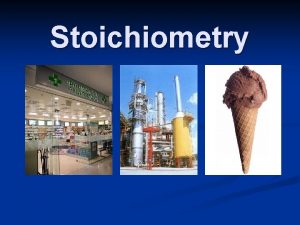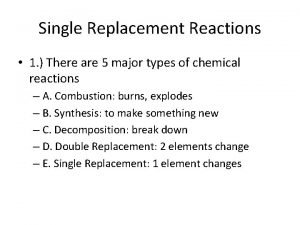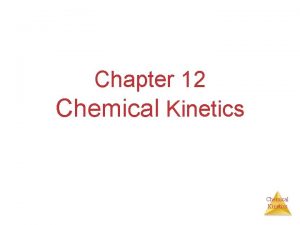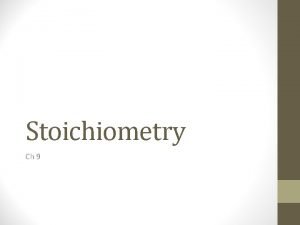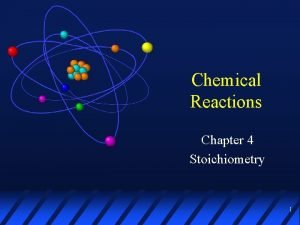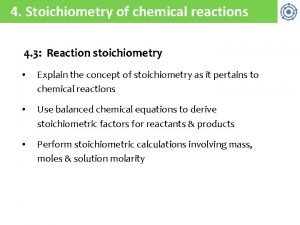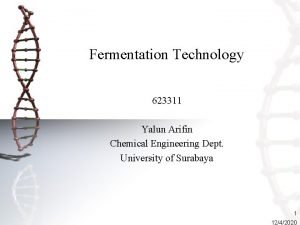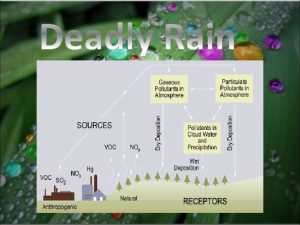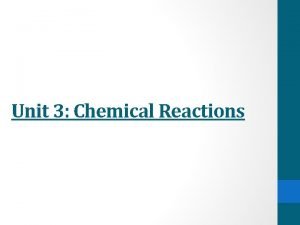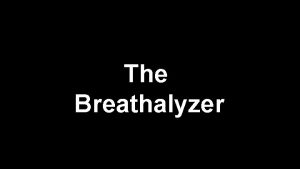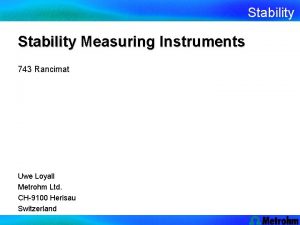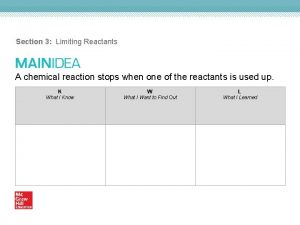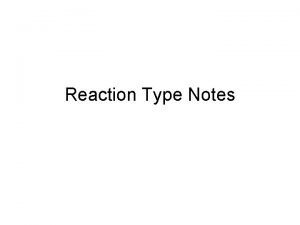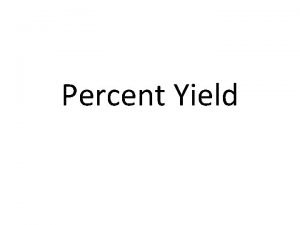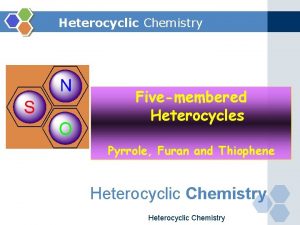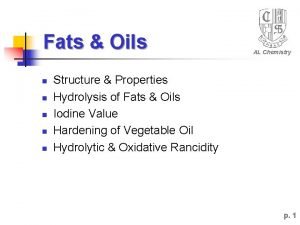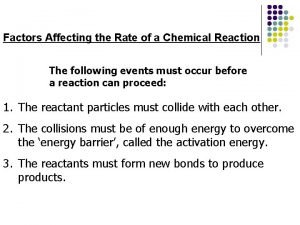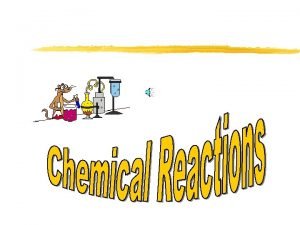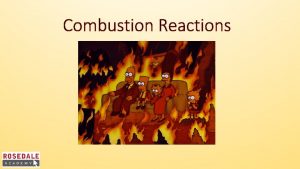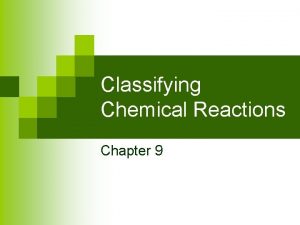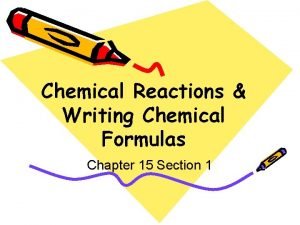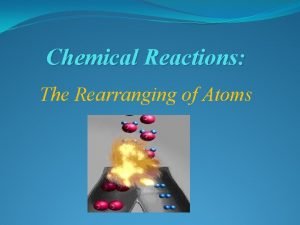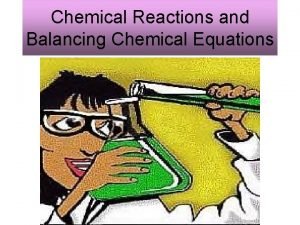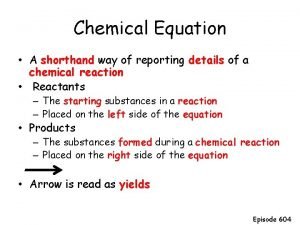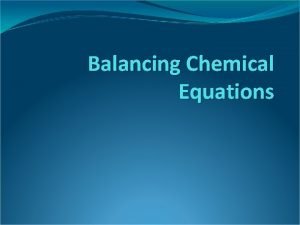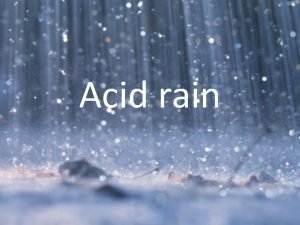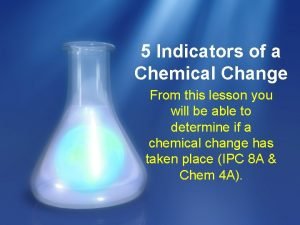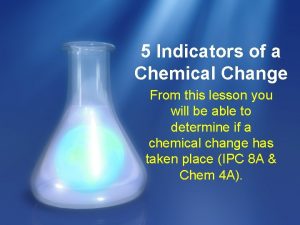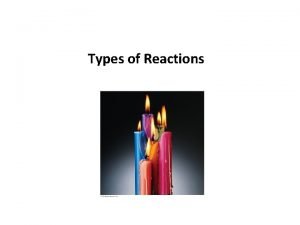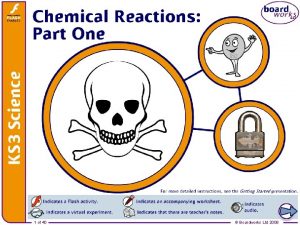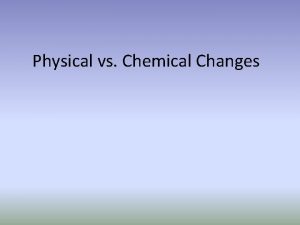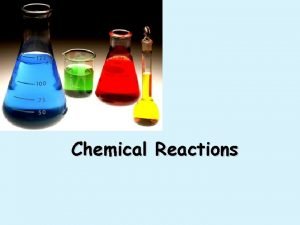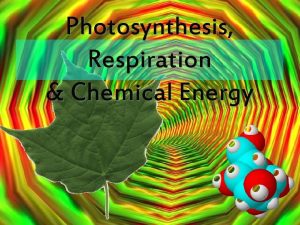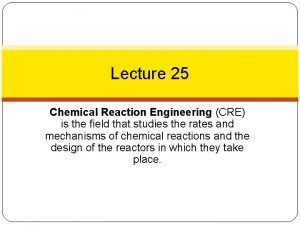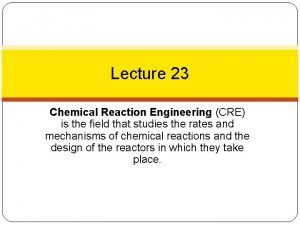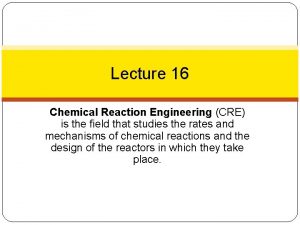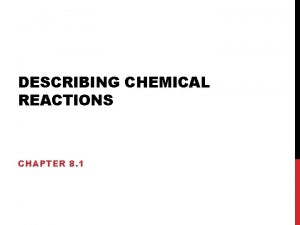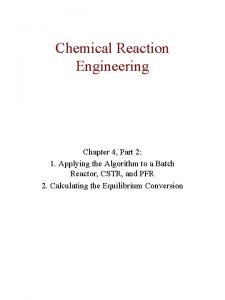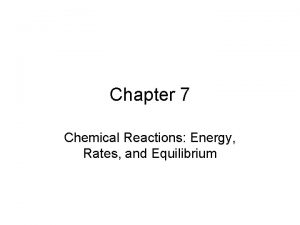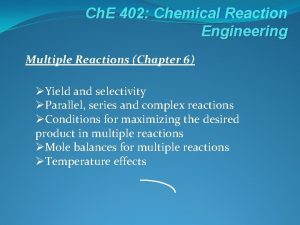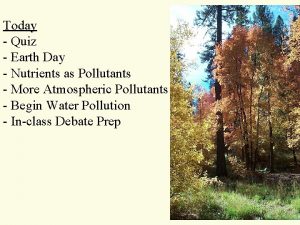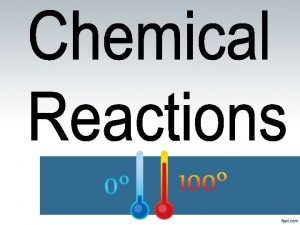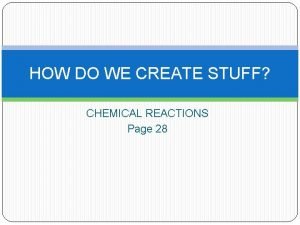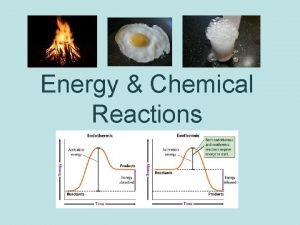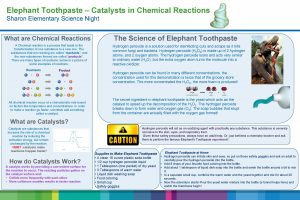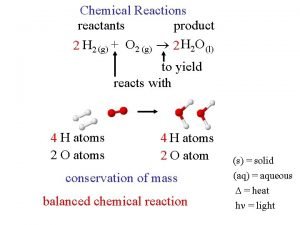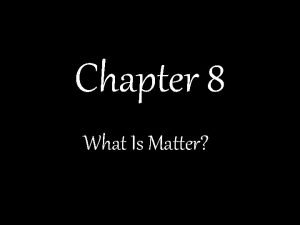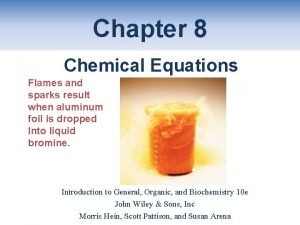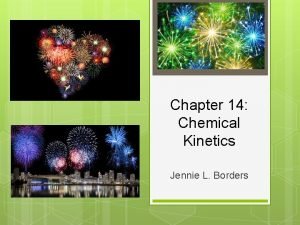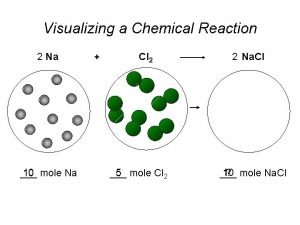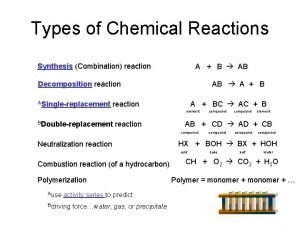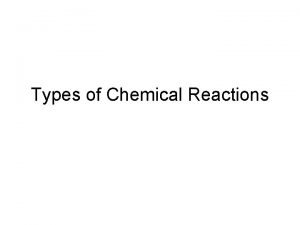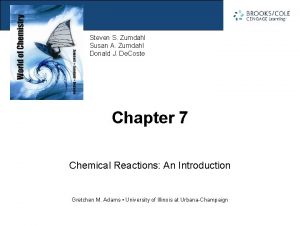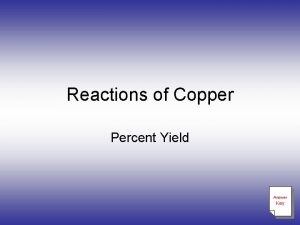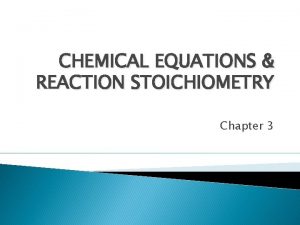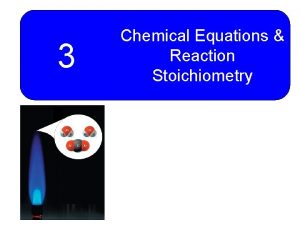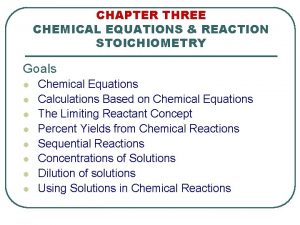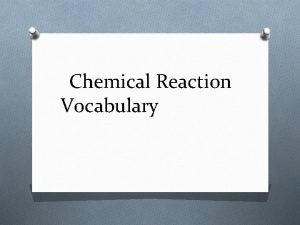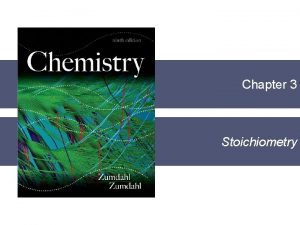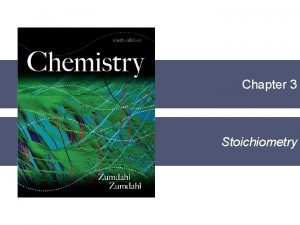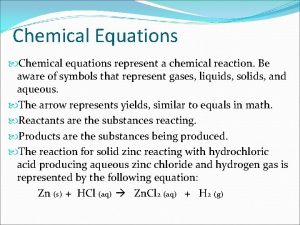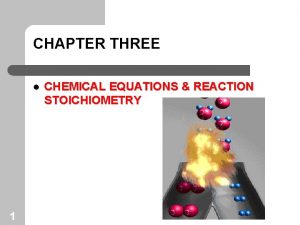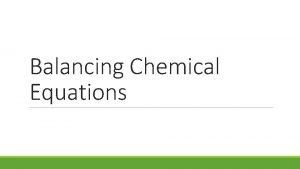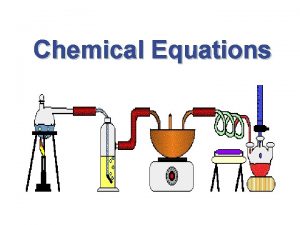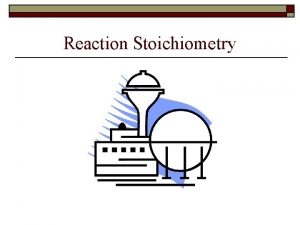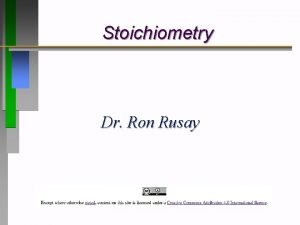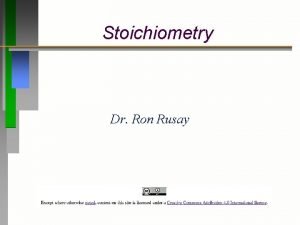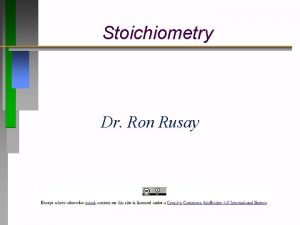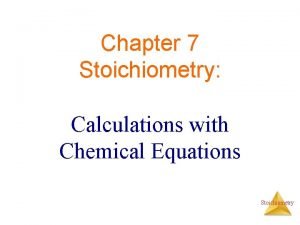3 Chemical Equations Reaction Stoichiometry Chapter Three Goals














































































- Slides: 78

3 Chemical Equations & Reaction Stoichiometry

Chapter Three Goals 1. 2. 3. 4. 5. 6. 7. 8. 9. Chemical Equations Calculations Based on Chemical Equations The Limiting Reactant Concept Percent Yields from Chemical Reactions Sequential Reactions Concentrations of Solutions Dilution of solutions Using Solutions in Chemical Reactions Synthesis Question 2

Chemical Equations • Symbolic representation of a chemical reaction that shows: 1. reactants on left side of reaction 2. products on right side of equation 3. relative amounts of each using stoichiometric coefficients 3

Chemical Equations • Attempt to show on paper what is happening at the laboratory and molecular levels. 4

Chemical Equations • Look at the information an equation provides: 5

Chemical Equations • Look at the information an equation provides: reactants yields products 6

Chemical Equations • Look at the information an equation provides: reactants 1 formula unit yields 3 molecules products 2 atoms 3 molecules 7

Chemical Equations • Look at the information an equation provides: reactants 1 formula unit 1 mole yields 3 molecules 3 moles products 2 atoms 3 molecules 2 moles 3 moles 8

Chemical Equations • Look at the information an equation provides: reactants yields 1 formula unit 3 molecules 1 mole 3 moles 159. 7 g 84. 0 g products 2 atoms 2 moles 111. 7 g 132 g 9

Chemical Equations • Law of Conservation of Matter – There is no detectable change in quantity of matter in an ordinary chemical reaction. – Balanced chemical equations must always include the same number of each kind of atom on both sides of the equation. – This law was determined by Antoine Lavoisier. • Propane, C 3 H 8, burns in oxygen to give carbon dioxide and water. 10

Law of Conservation of Matter • NH 3 burns in oxygen to form NO & water You do it! 11

Law of Conservation of Matter • NH 3 burns in oxygen to form NO & water 12

Law of Conservation of Matter • C 7 H 16 burns in oxygen to form carbon dioxide and water. You do it! 13

Law of Conservation of Matter • C 7 H 16 burns in oxygen to form carbon dioxide and water. 14

Law of Conservation of Matter • C 7 H 16 burns in oxygen to form carbon dioxide and water. • Balancing equations is a skill acquired only with lots of practice – work many problems 15

Calculations Based on Chemical Equations • Can work in moles, formula units, etc. • Frequently, we work in mass or weight (grams or kg or pounds or tons). 16

Calculations Based on Chemical Equations • Example 3 -1: How many CO molecules are required to react with 25 formula units of Fe 2 O 3? 17

Calculations Based on Chemical Equations • Example 3 -2: How many iron atoms can be produced by the reaction of 2. 50 x 105 formula units of iron (III) oxide with excess carbon monoxide? 18

Calculations Based on Chemical Equations • Example 3 -2: How many iron atoms can be produced by the reaction of 2. 50 x 105 formula units of iron (III) oxide with excess carbon monoxide? 19

Calculations Based on Chemical Equations • Example 3 -2: How many iron atoms can be produced by the reaction of 2. 50 x 105 formula units of iron (III) oxide with excess carbon monoxide? 20

Calculations Based on Chemical Equations • Example 3 -3: What mass of CO is required to react with 146 g of iron (III) oxide? 21

Calculations Based on Chemical Equations • Example 3 -3: What mass of CO is required to react with 146 g of iron (III) oxide? 22

Calculations Based on Chemical Equations • Example 3 -3: What mass of CO is required to react with 146 g of iron (III) oxide? YOU MUST BE PROFICIENT WITH THESE TYPES OF PROBLEMS!!! 23

Limiting Reactant Concept • Kitchen example of limiting reactant concept. 1 packet of muffin mix + 2 eggs + 1 cup of milk 12 muffins • How many muffins can we make with the following amounts of mix, eggs, and milk? 24

Limiting Reactant Concept • Mix Packets Eggs Milk 1 1 dozen 1 gallon limiting reactant is the muffin mix 2 1 dozen 1 gallon 3 1 dozen 1 gallon 4 1 dozen 1 gallon 5 1 dozen 1 gallon 6 1 dozen 1 gallon 7 1 dozen 1 gallon limiting reactant is the dozen eggs 25

Limiting Reactant Concept • Look at a chemical limiting reactant situation. Zn + 2 HCl Zn. Cl 2 + H 2 26

Limiting Reactant Concept • Example 3 -8: What is the maximum mass of sulfur dioxide that can be produced by the reaction of 95. 6 g of carbon disulfide with 110. g of oxygen? 27

Limiting Reactant Concept • Example 3 -8: What is the maximum mass of sulfur dioxide that can be produced by the reaction of 95. 6 g of carbon disulfide with 110. g of oxygen? 28

Limiting Reactant Concept • Example 3 -8: What is the maximum mass of sulfur dioxide that can be produced by the reaction of 95. 6 g of carbon disulfide with 110. g of oxygen? 29

Limiting Reactant Concept • Example 3 -8: What is the maximum mass of sulfur dioxide that can be produced by the reaction of 95. 6 g of carbon disulfide with 110. g of oxygen? 30

Limiting Reactant Concept What do we do next? You do it! 31

Limiting Reactant Concept • • Which is limiting reactant? Limiting reactant is O 2. What is maximum mass of sulfur dioxide? Maximum mass is 147 g. 32

Percent Yields from Reactions • Theoretical yield is calculated by assuming that the reaction goes to completion. – Determined from the limiting reactant calculation. • Actual yield is the amount of a specified pure product made in a given reaction. – In the laboratory, this is the amount of product that is formed in your beaker, after it is purified and dried. • Percent yield indicates how much of the product is obtained from a reaction. 33

Percent Yields from Reactions • Example 3 -9: A 10. 0 g sample of ethanol, C 2 H 5 OH, was boiled with excess acetic acid, CH 3 COOH, to produce 14. 8 g of ethyl acetate, CH 3 COOC 2 H 5. What is the percent yield? 34

Percent Yields from Reactions 35

Percent Yields from Reactions 36

Percent Yields from Reactions 37

Percent Yields from Reactions 38

Sequential Reactions • Example 3 -10: Starting with 10. 0 g of benzene (C 6 H 6), calculate theoretical yield of nitrobenzene (C 6 H 5 NO 2) and of aniline (C 6 H 5 NH 2). 39

Sequential Reactions 40

Sequential Reactions • Next calculate the mass of aniline produced. You do it! 41

Sequential Reactions 42

Sequential Reactions 43

Concentration of Solutions • Solution is a mixture of two or more substances dissolved in another. – Solute is the substance present in the smaller amount. – Solvent is the substance present in the larger amount. – In aqueous solutions, the solvent is water. • The concentration of a solution defines the amount of solute dissolved in the solvent. – The amount of sugar in sweet tea can be defined by its concentration. • One common unit of concentration is: 44

Concentration of Solutions • Example 3 -11: What mass of Na. OH is required to prepare 250. 0 g of solution that is 8. 00% w/w Na. OH? 45

Concentration of Solutions • Example 3 -12: Calculate the mass of 8. 00% w/w Na. OH solution that contains 32. 0 g of Na. OH. 46

Concentration of Solutions • Example 3 -13: Calculate the mass of Na. OH in 300. 0 m. L of an 8. 00% w/w Na. OH solution. Density is 1. 09 g/m. L. You do it! 47

Concentrations of Solutions • Example 3 -14: What volume of 12. 0% KOH contains 40. 0 g of KOH? The density of the solution is 1. 11 g/m. L. You do it! 48

Concentrations of Solutions • Example 3 -14: What volume of 12. 0% KOH contains 40. 0 g of KOH? The density of the solution is 1. 11 g/m. L. 49

Concentrations of Solutions • Second common unit of concentration: 50

Concentrations of Solutions • Example 3 -15: Calculate the molarity of a solution that contains 12. 5 g of sulfuric acid in 1. 75 L of solution. You do it! 51

Concentrations of Solutions • Example 3 -15: Calculate the molarity of a solution that contains 12. 5 g of sulfuric acid in 1. 75 L of solution. 52

Concentrations of Solutions • Example 3 -15: Calculate the molarity of a solution that contains 12. 5 g of sulfuric acid in 1. 75 L of solution. 53

Concentrations of Solutions • Example 3 -16: Determine the mass of calcium nitrate required to prepare 3. 50 L of 0. 800 M Ca(NO 3)2. You do it! 54

Concentrations of Solutions • Example 3 -16: Determine the mass of calcium nitrate required to prepare 3. 50 L of 0. 800 M Ca(NO 3)2. 55

Concentrations of Solutions • One of the reasons that molarity is commonly used is because: M x L = moles solute and M x m. L = mmol solute M V = mol 56

Concentrations of Solutions • Example 3 -17: The specific gravity of concentrated HCl is 1. 185 and it is 36. 31% w/w HCl. What is its molarity? 57

Concentrations of Solutions • Example 3 -17: The specific gravity of concentrated HCl is 1. 185 and it is 36. 31% w/w HCl. What is its molarity? 58

Concentrations of Solutions • Example 3 -17: The specific gravity of concentrated HCl is 1. 185 and it is 36. 31% w/w HCl. What is its molarity? 59

Dilution of Solutions • To dilute a solution, add solvent to a concentrated solution. – One method to make tea “less sweet. ” – How fountain drinks are made from syrup. • The number of moles of solute in the two solutions remains constant. • The relationship M 1 V 1 = M 2 V 2 is appropriate for dilutions, but not for chemical reactions. 60

Dilution of Solutions • Common method to dilute a solution involves the use of volumetric flask, pipet, and suction bulb. 61

Dilution of Solutions • Example 3 -18: If 10. 0 m. L of 12. 0 M HCl is added to enough water to give 100. m. L of solution, what is the concentration of the solution? 62

Dilution of Solutions • Example 3 -19: What volume of 18. 0 M sulfuric acid is required to make 2. 50 L of a 2. 40 M sulfuric acid solution? You do it! 63

Dilution of Solutions • Example 3 -19: What volume of 18. 0 M sulfuric acid is required to make 2. 50 L of a 2. 40 M sulfuric acid solution? 64

Using Solutions in Chemical Reactions • Combine the concepts of molarity and stoichiometry to determine the amounts of reactants and products involved in reactions in solution. 65

Using Solutions in Chemical Reactions • Example 3 -20: What volume of 0. 500 M Ba. Cl 2 is required to completely react with 4. 32 g of Na 2 SO 4? 66

Using Solutions in Chemical Reactions • Example 3 -20: What volume of 0. 500 M Ba. Cl 2 is required to completely react with 4. 32 g of Na 2 SO 4? 67

Using Solutions in Chemical Reactions • Example 3 -20: What volume of 0. 500 M Ba. Cl 2 is required to completely react with 4. 32 g of Na 2 SO 4? 68

Using Solutions in Chemical Reactions • Example 3 -21: (a)What volume of 0. 200 M Na. OH will react with 50. 0 m. L 0 f 0. 200 M aluminum nitrate, Al(NO 3)3? 69

Using Solutions in Chemical Reactions • Example 3 -20: (a)What volume of 0. 200 M Na. OH will react with 50. 0 m. L 0 f 0. 200 M aluminum nitrate? 70

Using Solutions in Chemical Reactions • (b)What mass of Al(OH)3 precipitates in (a)? You do it! 71

Using Solutions in Chemical Reactions • (b) What mass of Al(OH)3 precipitates in (a)? 72

Using Solutions in Chemical Reactions • Titrations are a method of determining the concentration of an unknown solutions from the known concentration of a solution and solution reaction stoichiometry. – Requires special lab glassware • Buret, pipet, and flasks – Must have an indicator also 73

Using Solutions in Chemical Reactions • Example 3 -22: What is the molarity of a KOH solution if 38. 7 m. L of the KOH solution is required to react with 43. 2 m. L of 0. 223 M HCl? 74

Using Solutions in Chemical Reactions • Example 3 -22: What is the molarity of a KOH solution if 38. 7 m. L of the KOH solution is required to react with 43. 2 m. L of 0. 223 M HCl? 75

Using Solutions in Chemical Reactions • Example 3 -22: What is the molarity of a KOH solution if 38. 7 m. L of the KOH solution is required to react with 43. 2 m. L of 0. 223 M HCl? 76

Using Solutions in Chemical Reactions • Example 3 -22: What is the molarity of a KOH solution if 38. 7 m. L of the KOH solution is required to react with 43. 2 m. L of 0. 223 M HCl? 77

3 Chemical Equations & Reaction Stoichimoetry
 Strategic goals tactical goals operational goals
Strategic goals tactical goals operational goals Strategic goals tactical goals operational goals
Strategic goals tactical goals operational goals In a chemical reaction, stoichiometry refers to
In a chemical reaction, stoichiometry refers to Chapter 18 chemical reactions balancing chemical equations
Chapter 18 chemical reactions balancing chemical equations Activity formula
Activity formula Translating chemical equations
Translating chemical equations Define reaction stoichiometry
Define reaction stoichiometry Single replacement definition chemistry
Single replacement definition chemistry Reaction rate and stoichiometry
Reaction rate and stoichiometry Chemical rxns/balancing equ./stoichiometry
Chemical rxns/balancing equ./stoichiometry Types of chemical reactions and solution stoichiometry
Types of chemical reactions and solution stoichiometry Types of chemical reactions and solution stoichiometry
Types of chemical reactions and solution stoichiometry Chemical accounting stoichiometry
Chemical accounting stoichiometry Chemical accounting: stoichiometry
Chemical accounting: stoichiometry Stoichiometry map for chemical reactions
Stoichiometry map for chemical reactions Fermenter types
Fermenter types Chapter 11 stoichiometry assessment answer key
Chapter 11 stoichiometry assessment answer key General goals and specific goals
General goals and specific goals Examples of generic goals and product-specific goals
Examples of generic goals and product-specific goals Chapter 7 review chemical formulas and chemical compounds
Chapter 7 review chemical formulas and chemical compounds What is the chemical formula for tetranitrogen heptoxide?
What is the chemical formula for tetranitrogen heptoxide? Chemical equations and reactions chapter 8 review
Chemical equations and reactions chapter 8 review Chapter 8 section 1 chemical equations and reactions
Chapter 8 section 1 chemical equations and reactions Chemical equations and reactions chapter 8
Chemical equations and reactions chapter 8 Chapter 19 chemical reactions answer key
Chapter 19 chemical reactions answer key Unit of rate of reaction for first order reaction
Unit of rate of reaction for first order reaction Addition reaction and substitution reaction
Addition reaction and substitution reaction Leukoerythroblastic reaction vs leukemoid reaction
Leukoerythroblastic reaction vs leukemoid reaction Acid rain introduction
Acid rain introduction Word equation examples
Word equation examples Types of reactions
Types of reactions Oxidation of ethanol
Oxidation of ethanol Rancidity chemical reaction
Rancidity chemical reaction When does a chemical reaction stop
When does a chemical reaction stop Which type of reaction
Which type of reaction Percent yield efficiency
Percent yield efficiency Protonated pyrrole
Protonated pyrrole Rancidity chemical reaction
Rancidity chemical reaction What factors influence the rate of a chemical reaction
What factors influence the rate of a chemical reaction Phosphorus + oxygen equation
Phosphorus + oxygen equation Combustion reaction examples
Combustion reaction examples A chemist shorthand way of representing chemical reaction.
A chemist shorthand way of representing chemical reaction. Definition of lipids
Definition of lipids Rules of chemical reaction
Rules of chemical reaction Combustion chemical reaction definition
Combustion chemical reaction definition Rearranging atoms
Rearranging atoms Balanced equations
Balanced equations A chemists shorthand way of representing chemical reaction
A chemists shorthand way of representing chemical reaction A chemist shorthand way of presenting chemical reaction
A chemist shorthand way of presenting chemical reaction Rainoutcomes
Rainoutcomes What are the 5 indicators of a chemical change
What are the 5 indicators of a chemical change 5 indicators of chemical reaction
5 indicators of chemical reaction Exothermic reaction examples
Exothermic reaction examples Yeast chemical reaction
Yeast chemical reaction Is baking cookies a physical change
Is baking cookies a physical change Aluminum and iron iii oxide balanced equation
Aluminum and iron iii oxide balanced equation Starting substances in a chemical reaction
Starting substances in a chemical reaction Did a chemical reaction occur
Did a chemical reaction occur Chemical reaction engineering
Chemical reaction engineering Chemical reaction engineering
Chemical reaction engineering Chemical reaction engineering
Chemical reaction engineering Describing chemical reactions
Describing chemical reactions Chemical reaction engineering
Chemical reaction engineering Did a chemical reaction occur
Did a chemical reaction occur Series reaction example
Series reaction example Earth day quiz
Earth day quiz Indications of chemical reaction
Indications of chemical reaction Toothpaste chemical equation
Toothpaste chemical equation Concentration in chemical reaction
Concentration in chemical reaction Elephant toothpaste chemical reaction
Elephant toothpaste chemical reaction What are the reactants in this chemical reaction?
What are the reactants in this chemical reaction? Odor change example
Odor change example Chemical equation of phosphorus
Chemical equation of phosphorus Concentration in chemical reaction
Concentration in chemical reaction Mole
Mole Examples for chemical combination reaction
Examples for chemical combination reaction Combustion chemical reaction
Combustion chemical reaction Evidence of chemical reaction
Evidence of chemical reaction Chemical reaction of copper and percent yield
Chemical reaction of copper and percent yield






